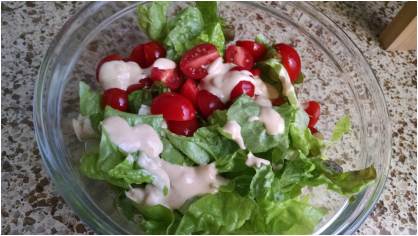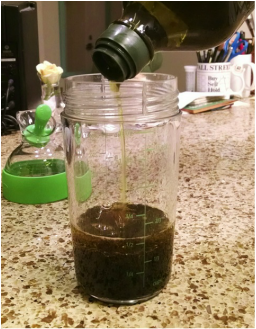 A simple salad with Molly's Tahini Dressing
A simple salad with Molly's Tahini Dressing Raise your hand if you are over winter and winter foods and just want a salad? Yes, salad! Great! In my mind, the dressing can make or break a salad. For a long time, I was faithful to bottled dressing at the grocery store. I never bothered to read the ingredient list or nutritional values. Nope, I went on taste.
Turns out when I was in the throes of my autoimmune illness many of the ingredients were making my symptoms worse (soy, gluten, sugar). So we started making salad dressing at home. And let me just tell you that everyone who comes to stay with us raves about Brian’s very simple and delicious vinaigrette, including my 14 year old cousin.
Have you ever read the ingredient list for a bottle of salad dressing? It’s often more than five items, some of them you’ve never heard of and can’t pronounce. What if I told you making salad dressing at home can be done in a few minutes using five ingredients or less? That’s right! It’s so easy, economical, and such an important step to moving away from processed foods.

Brian’s Balsamic Vinaigrette
Extra Virgin Olive Oil
Honey
Balsamic Vinegar (good quality)
Red Wine Vinegar (good quality)
You will need either a cruet with liquid volume measurements on it or a glass measuring cup that holds at least a pint. Fill to the ¼ cup line using equal amounts of each vinegar (just eyeball it). Then add honey so the total liquid volume measures 1/3 cup. Stir, whisk, or, in the case of the cruet, shake the vinegar and honey together to dissolve the honey. Add enough olive oil so that the total volume of all ingredients reaches the 1-cup line. Again, whisk or shake to emulsify and then use immediately. For the two of us, who eat 1 quart of salad each night, this lasts about five to six days. You will need to re-emulsify it each time you use it. Store in an airtight container in the refrigerator. If you are using good quality olive oil, it will harden in the fridge. Just take out the dressing about 30 minutes before dinner so it can temper.
Nutritional awesomeness: Olive oil is a monounsaturated fatty acid that has been shown to help lower bad cholesterol. It contains polyphenols which are powerful antioxidants. Studies in Europe have concluded that olive oil consumption helps lower blood pressure. One Greek study with 36,000 participants concluded that there is an inverse relationship between eating olive oil and rates of cancer. As it is still a fat, you want to consume it judiciously. Honey is anti-viral and anti-bacterial. In both ancient and modern times, it has proved effective in wound care. Balsamic vinegar has been shown to aid digestion, lower cholesterol and regulate blood sugar.
Molly’s Tahini Dressing
I developed this recipe after wondering what to do with all the tahini leftover from making a batch of hummus.
¼ cup tahini, well stirred
¼ cup warm water
2 T tamari (gluten free soy sauce)
1 T lemon juice
1 clove garlic, minced with a pinch of sea salt
Stir all the ingredients together in a small bowl or liquid measuring cup, slowly at first so they don’t splash out of the container. Stir until emulsified. Store in an airtight container in the refrigerator for up to five days. This is great for dressing salads as well as serving as an accompaniment to grilled chicken and grilled vegetables. It’s nice during this transition from winter to spring when you may desire something a little heartier on your salad. Enjoy!
Nutritional awesomeness: Tahini is a good source of omega-3 and omega-6 fatty acids, thiamin and copper. Lemon juice is a good source of vitamin C. It contains antioxidants in the form of flavonoids. It is effective in the prevention and treatment of certain kinds of kidney stones. Garlic is a wonder food and has been shown to help reduce symptoms of heart disease like high blood pressure and high LDL. It also has anti-viral properties.

 RSS Feed
RSS Feed